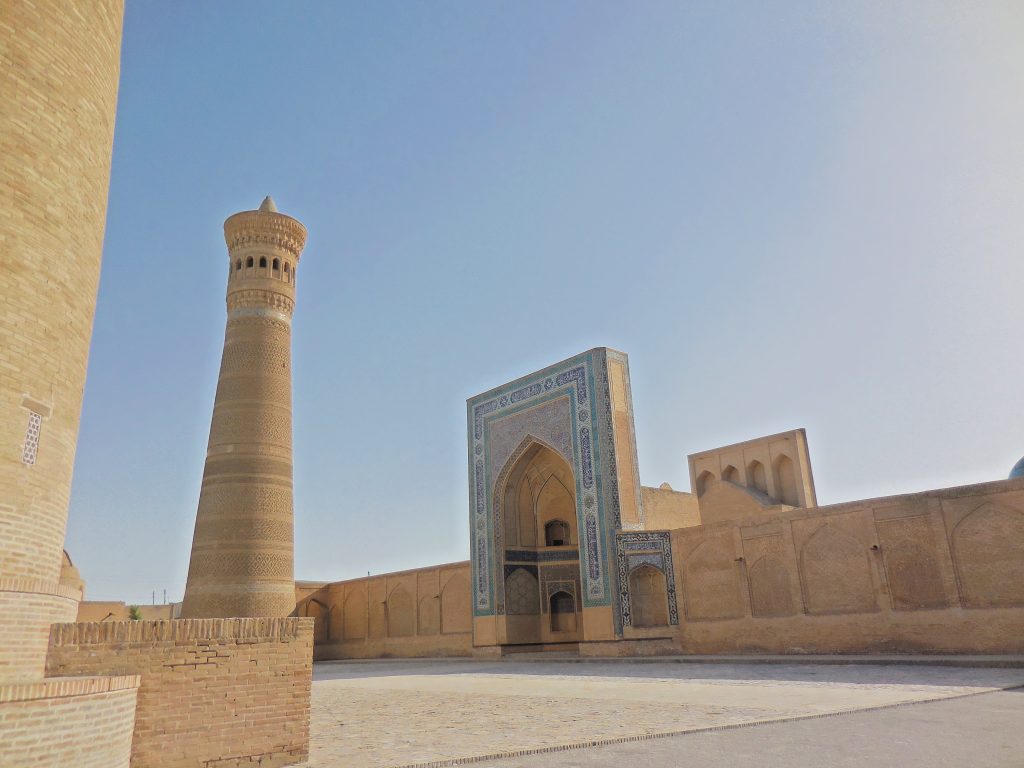Travel to Bukhara. Advises and historical background. Uzbekistan
Travel to Bukhara. Advises and historical background. Uzbekistan

Our hotel owner in Samarkand, not so happy to have to prepare breakfast at 7.00 am, insisted on explaining that it was useless to go so early to take the bus. “It leaves when it’s full!” he repeated stiffly. I, who had not appreciated his behavior, for scolding us for being back at the hotel at 11.00 pm, I did not listen to him. It reminded me too much of a friend of my parents, who when I was a young girl, assumed paternalistic attitudes about how the world worked and how I should behave like a “good girl”. The fifty-year-old hotelier, who was staring at me, was asking the same question: “Have you already been here? I think I know you!” “In a previous life, maybe” was my replay.
In conclusion we arrived around 8.00 a.m. at the indicated point, just outside the city, and we settled in the half empty bus without air conditioning. After 30 minutes, we started asking when we would had leave. Nobody answered us exactly. In the company of a Russian, after another hour of waiting, we tried to understand how much a shared taxi costs. The Russian shaked his head, letting me understand that the deal was off. Disconsolate, we resided on the bus and waited defeated our destiny. Each person who climbed in was an addition to my personal countdown: two and a half hours to fill every seat of the old bus; finally we leaved!
The journey between Samarkand and Bukhara

As it had already happened to me in India, new passengers were coming up at every stop, settle themselves by opening reclosable seats between the two rows of fixed armchairs, until even those were completely used. At the back I kept observing the movements of the Uzbeks: elegant women loaded with bags returning home after shopping, young people sitting on top of each other to make room for the elderly still lively and with the head rigorously covered by the traditional hat. Traveling by bus you always have the privilege to mix with the locals and to observe the simple everyday life.
After a couple of hours of travel, in the barren Uzbek countryside tinted here and there by small deciduous forests and flat villages teeming with markets and busy people, the bus stopped and we were toldto to take another one to reach the destination . So we climbed on a small city bus and we could sit down, as most of the passengers had already arrived at their destination. The new vehicle is filled with luggage and cartons and soon we leaved again. Another hour of travel and we finally arrived to Bukhara, just after lunch.
By the central bus station, just outside of the historic city walls, we took a taxi to the chosen hotel; we stayed in the center, in a beautiful hotel that incorporates the architectural style of the ancient village, right near the Madras Nadir Divan-Begi. Paying the room in Som, I found myself forced to discuss the change in reception, where a smiling girl tried to make me pay more …
Historical hints
The origins of Bukhara dates back to the 5th century BC and, according to mythology, the Iranian prince Siyavash, same hero of the epic poem Shanameh, founded and decorated the site with magnificent palaces and gardens. In the historical region of Sogd, the center of the town was the Arch, where it is still possible to visit the palace of the ruler. The town, called Sharistan and the Rabads, stretched around, where commercial exchanges were made and the craftsmen worked on their artifacts. The city’s name derives from Bikhara, which means “convent”.
The Persians, Darius and Cyrus were in this region bringing Zoroastrianism in the 6th century BC .; while it is still unclear whether Alexander the Great went from here. Greek swords have recently been found on a hill called Kisil Kir, 40 km away from the center.
From the II to the III century AD the city was part of the kingdom of Kangju, which included Afghanistan, Iran and all of central Asia. Outside Kabul, jewels dating back to this period were found by Bukhara artisans. In the 5th century AD it was affiliated with the kingdom of the Ephthalites; while in the VI and VII centuries the western Turkish khaghanat.
The modern era

In the last century Islam spreads throughout the kingdom, until it is considered in the 9th century “the dome of Islam”, because it is an important cultural and religious center. Avicenna was born 30 m away from here, in the village of Afshana; nowadays in his reconstructed house there is a museum about this great philosopher. From this period begins the construction of Mosques, Madras and minarets. The wall that still encloses the historic center dates back to the 16th century and contained more than 200 madras and numerous bazaars.
Like Samarkand, also Bukhara was conquered by Genghis Khan in 1220 and, later, fell under the influence of Tamerlane in 1370. Between 1261 and 1264, Marco Polo stayed here; testifying how the thriving city was on the Silk Road route.
Today’s appearance dates back to the Samanid and Astaranid dynasties (between the 16th and 17th centuries); the first conquered the Transoxania region at the beginning of 1500 and they begin the Khaghanat of Bukhara, a countyr-state that also includes Samarkand. In 1860 the region was conquered by the Russians, who keep the khaghanat until the October revolution.
Bukhara became part of today’s Uzbekistan, which has now been autonomous among the CIS countries. In 1991, the historic center enters UNESCO protected sites.
For more travel information and tips for Samarkand, click here.

Pingback: Complex Poi Kalyan. Madras, Mosque and Kalyan Minaret, Bukhara | Central Asia
Pingback: Complex Poi Kalyan. Madras, Mosque and Kalyan Minaret, Bukhara | Erica Leoni